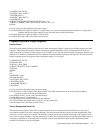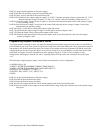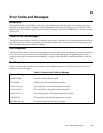
Programming with a Series 200/300 Computer102
LINE 10: Assigns the I/O path name to the power supply.
LINE 20: Declare a common block for the I/O path name.
LINE 30: Define interrupt on softkey depression and branch to error routine.
LINE 40: Idle on softkey definition.
LINE 80: Define subprogram Err_trap
LINE 90: Disable interrupt capability while processing.
LINE 100: Bring in the common block for the I/O pathname.
LINE 110,120: Enter error code from power supply.
LINE 130: Clears computer screen.
LINE 140,150: If an error occurred, print message.
LINE 170-420: Print message based on error code. Prompt user to try again. If no error occurred, print message saying no
error occurred.
Stored Operating States
Your power supply has registers that can store up to 10 operating states. These states can be recalled in arbitrary order.
Storing a state involves taking a "snapshot" of the voltage and current settings that are in effect when the command is
received. The following example uses stored operating states to set up an output. Using this method of setting up outputs
saves processing time and facilitates repeating the same commands.
10 ASSIGN @Ps TO 705
20 OUTPUT @Ps;"OUT1,0;OUT2,0"
30 !
40 OUTPUT @Ps;"VSET1,1;ISET1,.1;VSET2,5;ISET2,.1;5TOl"
50 OUTPUT @Ps;"VSET1,2;ISET1,.2;VSET2,4;ISET2,.2;STO2"
60 OUTPUT @Ps;’’VSET1,3;ISET1,.3;VSET2,3;ISET2,.3;STO3"
70 OUTPUT @Ps;"VSET1,4;ISET1,.4;VSET2,2;ISET2,.4;STO4’’
80 OUTPUT @Ps;"VSET1,5;1SET1,.5;VSET2,1;1SET2,.5;STO5"
90 !
100 OUTPUT @Ps;"CLR"
110 FOR State= 1 TO 5
120 OUTPUT @Ps;"RCL";State
130 WAIT 2
140 NEXT State
l50 END
LINE 10: Assigns the I/O pathname to the power supply.
LINE 20: Disables output 1 and output 2.
LINE 40-80: Stores 5 operating states for output 1 and output 2 in storage registers 1 through 5. Outputs not explicitly
programmed will store the settings that are in effect when the store command is received.
LINE 100: Clears the supply. All outputs are enabled and set to the initial power on state (0 volts; minimum current
setting).
LINE 110-140: Loops through the sequence of five states with a two second wait between states.
Programming Outputs Connected In Parallel
Only outputs that have equivalent voltage and current ratings can be connected in parallel.
When programming outputs that are connected in parallel, it is convenient if you first know if you will be operating in CC
or CV mode. Refer to Chapter 4 for more information on parallel operation.


















